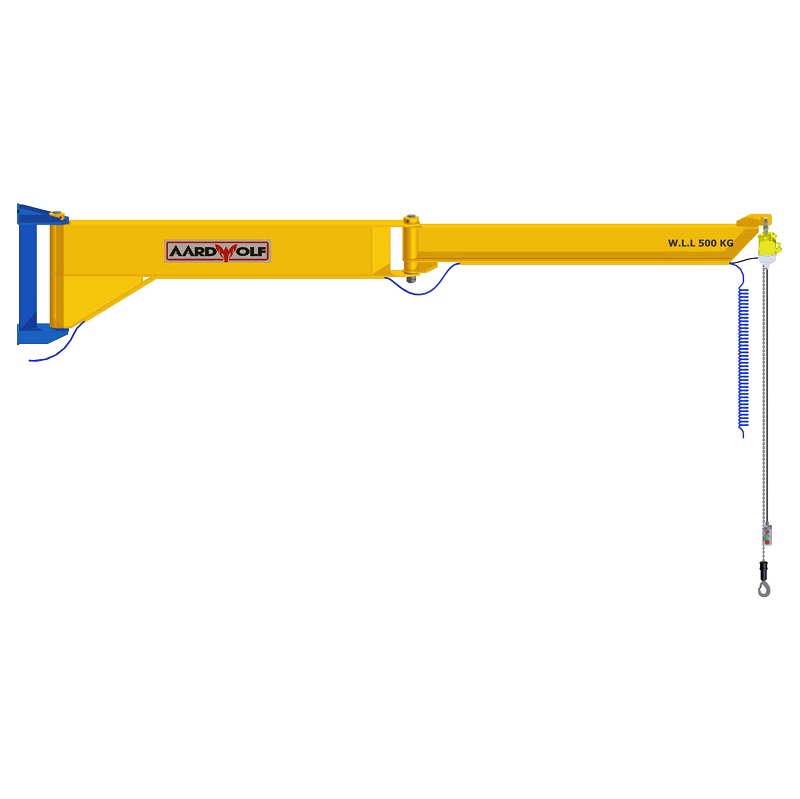Table of Contents
ToggleIntroduction
Jib cranes are vital tools in industrial, marine, and construction environments, designed to handle materials safely and efficiently. However, like any mechanical system, their performance and longevity depend on proper maintenance. Whether you’re operating an articulating jib crane in a workshop or a mast-mounted jib crane on a dock, consistent upkeep is essential to ensure safety, reliability, and cost-efficiency. This article covers essential jib crane maintenance tips and highlights their importance in optimizing jib crane applications.
Why Jib Crane Maintenance Matters
Ensuring Safe and Reliable Operation
Poorly maintained jib cranes pose significant safety hazards. Regular inspections and servicing help identify wear and potential failures before they escalate, reducing the risk of accidents and injuries. For industries relying on heavy lifting—such as those detailed in Jib Crane Applications in Marine and Port Operations—maintenance is non-negotiable.
Extending Crane Lifespan
Routine maintenance minimizes wear and tear, significantly extending a crane’s usable life. Preventative measures are more cost-effective than emergency repairs or complete crane replacement. Maintenance plans should be customized based on the crane type—be it a freestanding jib crane, wall-mounted jib crane, or mast-type jib crane.
Boosting Material Handling Efficiency
Well-maintained cranes operate smoothly, reducing operational delays and improving overall material handling efficiency. Learn more about the impact of jib cranes on efficiency from Jib Crane Applications That Boost Material Handling.
Daily, Weekly, and Monthly Maintenance Routines
Daily Inspection Checklist
- Visual Inspection: Check for obvious signs of damage, corrosion, or misalignment.
- Lubrication: Ensure all moving parts—especially pivot points in articulating jib cranes—are well-lubricated.
- Brakes and Limit Switches: Test for proper functioning.
- Load Chain or Wire Rope: Examine for kinks, breaks, or fraying.
Weekly Maintenance Tasks
- Tighten Bolts and Connections: Especially for wall-mounted and freestanding jib cranes, structural integrity is paramount.
- Check Electrical Components: Inspect wiring, control boxes, and pendant stations.
- Assess Mounting Systems: Verify that mast-type and mast-mounted cranes remain securely fixed.
Monthly Preventive Maintenance
- Inspect Bearings and Bushings: Clean and lubricate where necessary.
- Test Load Performance: Use test weights to ensure lifting capacity is maintained.
- Structural Evaluation: Look for fatigue, cracks, or metal deformation in load-bearing arms.
Specialized Tips by Jib Crane Type
Articulating Jib Cranes
- Monitor Articulation Points: Regularly inspect joints and hinges for wear.
- Ensure Free Movement: Check that arms move smoothly without obstruction.
Mast-Type and Mast Mounted Jib Cranes
- Inspect Anchoring Systems: Given their structural reliance, periodic verification of mast attachment is crucial.
- Corrosion Prevention: Especially important in marine or outdoor settings.
Freestanding Jib Cranes
- Foundation Integrity: Check the base for cracks or foundation shifting.
- Rotational Bearing Maintenance: Clean and lubricate for smooth 360-degree motion.
Wall-Mounted Jib Cranes
- Wall Bracket Stability: Ensure that the structure the crane is mounted to remains robust.
- Track and Trolley Systems: Clean and align regularly for optimal load travel.
Environmental Considerations
Indoor vs. Outdoor Maintenance
Different environments affect crane maintenance frequency:
- Indoor Settings: Less exposure to weather, but dust and humidity can still impact electrical systems. Review Jib Crane Applications for Indoor and Outdoor Settings for insights.
- Outdoor Settings: Exposure to rain, salt, and UV rays necessitates rust prevention and more frequent lubrication.
Harsh Operating Conditions
In environments like ports or chemical plants, maintenance intervals should be shortened. Use weather-resistant lubricants and regularly clean crane surfaces.
Compliance and Documentation
Adhering to Industry Standards
Follow OSHA, ANSI, and manufacturer-specific maintenance guidelines to ensure safety and regulatory compliance.
Maintenance Logs
Always document:
- Inspections
- Repairs
- Replacements
- Technician details
Maintaining accurate logs helps prove compliance, track crane history, and plan future servicing schedules.
Partnering with Certified Technicians
For complex repairs or annual inspections, hire certified professionals. Their expertise ensures:
- Proper diagnostics
- Genuine parts replacement
- Compliance with safety standards
Experienced professionals bring the level of trust and authoritativeness required to handle your critical lifting equipment.
Conclusion
Maximizing the lifespan and performance of jib cranes demands a structured and consistent maintenance routine. From daily inspections to monthly preventive checks, every task contributes to the crane’s safe and efficient operation. Whether operating a mast-mounted jib crane on a dock or an articulating jib crane in a manufacturing facility, proactive care is the key to long-term reliability.
To explore more jib crane types and their applications, visit Aardwolf Jib Cranes.


















Please log in to leave a comment.